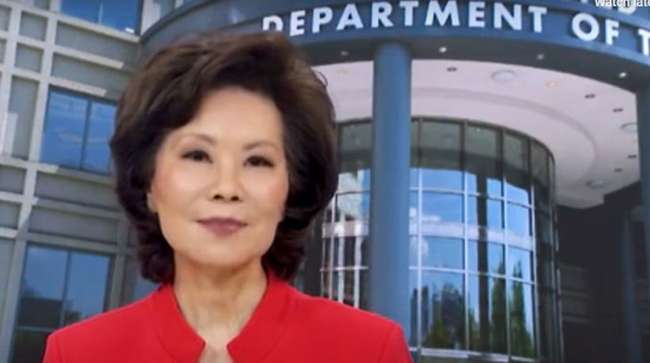Staff Reporter
DOT Releases National Freight Strategic Plan

[Stay on top of transportation news: Get TTNews in your inbox.]
U.S. Department of Transportation officials convened virtually to unveil the comprehensive National Freight Strategic Plan on Sept. 3.
Required by the Fixing America’s Surface Transportation Act, the National Freight Strategic Plan is meant to help inform infrastructure planning and support the efficiency of freight movement. The plan identifies improving the safety of the freight system, modernizing infrastructure and supporting the development of data and technologies as primary goals.
Economic competitiveness is closely tied to a strong infrastructure network, the plan indicates. During her remarks, Transportation Secretary Elaine Chao indicated investment in the freight system can help the U.S. remain competitive in industries such as agriculture, energy production and manufacturing.
National Freight Strategic Plan by Transport Topics on Scribd
“This system helps drive economic growth and touches the lives of every American,” Chao said. “This plan establishes a clear vision for the future of our nation’s transportation system.”
The 118-page plan identifies trends, challenges and areas for opportunity associated with freight movement. One major issue is e-commerce, which has contributed to increased truck traffic and competition for curb space. Trucks are the primary mode of transportation for shipments that move fewer than 750 miles, the plan states.
The plan notes that e-commerce shopping habits are increasing rapidly, creating a demand for deliveries in areas that already experience congestion issues. U.S. Census Bureau data indicates e-commerce sales increased 16.7% between the fourth quarters of 2018 and 2019. E-commerce trends have continued as stay-at-home orders brought on by the coronavirus pandemic have prompted more people to shop from home.
Today @SecElaineChao made an historic announcement on America’s freight system: https://t.co/ejbVwbvhm7 — TransportationGov (@USDOT) September 3, 2020
“The rise of e-commerce has disrupted our supply chains and increased demand for last-mile deliveries in areas that are already heavily congested,” Chao said. “This National Freight Strategic Plan will help us invest strategically in our country’s future and turn these challenges into opportunities.”
Besides encouraging e-commerce, the coronavirus pandemic will bear implications on the way Americans travel, noted Joel Szabat, undersecretary for transportation policy at DOT.
“Focused attention on the freight system is especially urgent in light of supply chain challenges caused by the recent pandemic,” said Wiley Deck, deputy administrator of the Federal Motor Carrier Safety Administration. “To continue moving forward, we need a holistic plan for our freight system. The National Freight Strategic Plan is such a plan.”
Technology is an area identified by the plan that carries numerous possibilities for the transportation industry. Advanced technologies, such as truck platooning and automation systems at ports, have the potential to improve safety and lower costs, the plan states.

Szabat
Federal Highway Administrator Nicole Nason mentioned that technology can play a role in trucking activity, such as through electronic routing systems and weigh-in-motion sensors.
“Freight movement is often intermodal,” Nason said. “Even if airports, seaports or railroads are involved, trucks are still needed to move those products to their final destinations.”
The plan discusses challenges associated with traffic congestion and includes a map of state-identified bottlenecks. Certain structural conditions, such as weight-restricted bridges and road geometries, can exacerbate bottlenecks. The American Transportation Research Institute estimates the trucking industry loses $74.5 billion a year sitting in traffic.
DOT will use the plan to guide national policy, inform state freight plans, identify data and research needs, and offer a framework for multimodal partnerships.
Szabat said DOT was involved in 13 events to gather input on the plan. He indicated the agency received 82 public comments from industry representatives.
“We look forward to continuing to work with you all as we strive to improve the safety and efficiency of our nation’s multimodal freight systems,” Szabat said.
Organizations that consider the interests of truck drivers, such as American Trucking Associations and the Owner-Operator Independent Drivers Association, were represented in the public comments DOT received.
ATA Vice President of Highway Policy Darrin Roth told Transport Topics the plan offers practical solutions to present and future challenges that face freight transportation providers.
“[The plan] recognizes the promise of technological solutions to safety, environmental and mobility concerns while acknowledging the need to make significant investments to modernize our nation’s transportation infrastructure,” Roth said.
Want more news? Listen to today's daily briefing:
Subscribe: Apple Podcasts | Spotify | Amazon Alexa | Google Assistant | More

